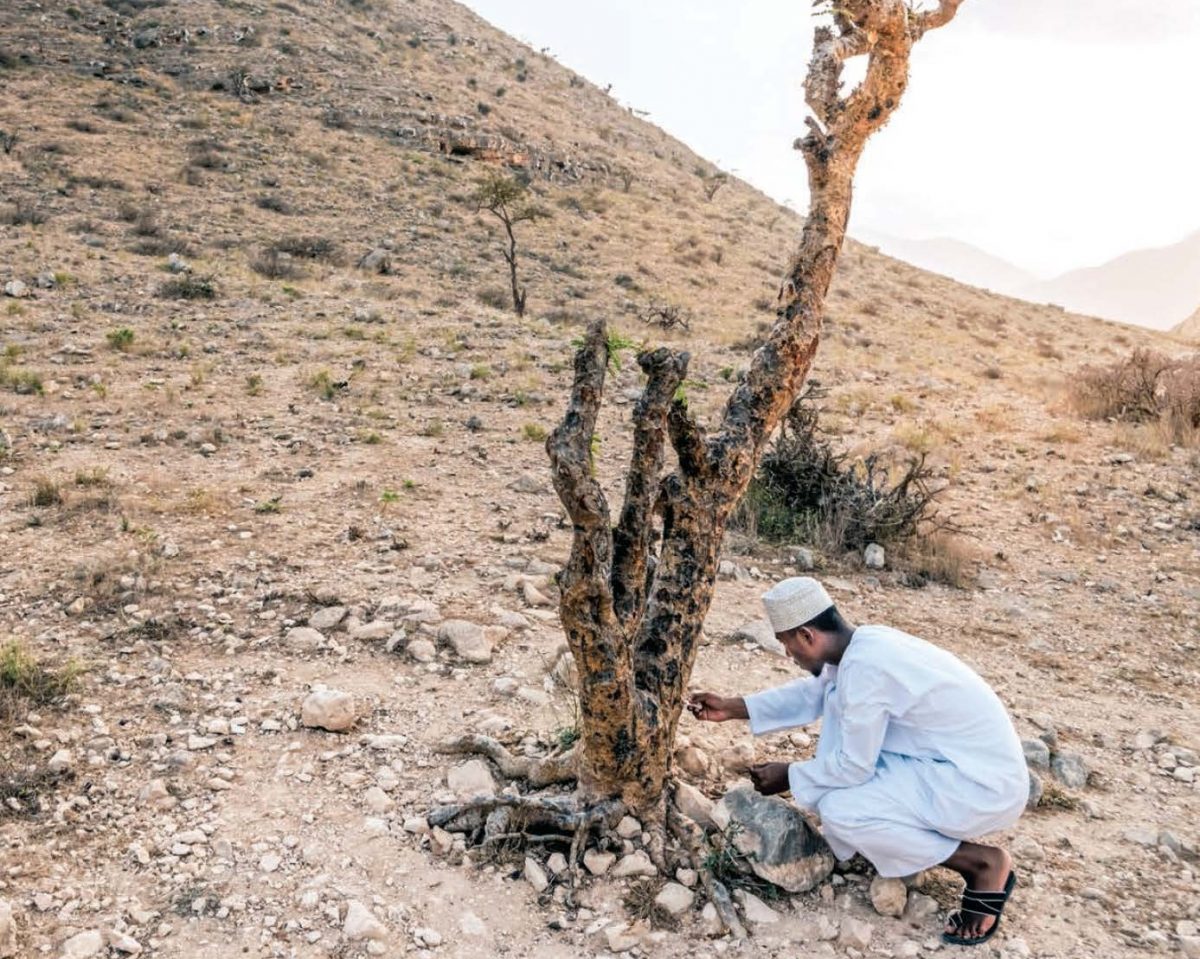“Close your eyes and breathe three times,” a soothing voice murmurs. I inhale deeply, breathing in the fragrant smoke that’s gently wafting in front of me. Eucalyptus-like notes blend with sweet musk into an unmistakable, ancient scent. I slowly lift my eyelids to see a wooden burner cradling a small cluster of amber-like rocks, coated in a silvery dust and emitting a spiral of white smoke where they hit hot, black coals.
I’m in the middle of a “frankincense ritual” at the Al Baleed Resort in Salalah, in the southern Omani region of Dhofar. The 90-minute spa treatment – which begins with a frankincense and ginger-infused drink and ends with an outrageously pampering, four-hand massage – centres on a substance that has been the backbone of this region for more than 5,000 years.
Frankincense – a gum resin that is tapped from a tree and hardened to be burnt as incense – can be harvested in Yemen, Somalia, Ethiopia and Sudan, but much of it comes from native Boswellia sacra trees in Oman, where it’s one of the main sources of income for its people. Considered to produce the highest-quality resin, this gnarled, spiky shrub – which looks like an olive tree that’s toughened up for the harsh desert climate – is found in the rocky plains surrounding Salalah, and along its stunning Eftalquot coastline, where wild turtles and dolphins splash in turquoise surf that washes over white sand beaches.
A visit to Salalah’s sleepy Hafa souq reveals how frankincense is distilled into essential oil and made into creams and soaps, which are stacked high in tiny shops. Thanks to its mythological, medicinal properties, frankincense oil is used to treat everything from swollen joints and stomach aches to acne, wrinkles and rashes. Inland trees produce better resin, as seaside moisture in the air can lead to impurities, and there are four quality grades of frankincense: the lowest grade has a brown, opaque hue, while the highest-quality – hojari – has a golden-green sheen. Fetching around 50 Omani rial (US$130) per kilo today, hojari frankincense has been one of the country’s most precious exports for some 2,000 years: in the second century BC the resin was worth more than gold and the southern Arabian peninsula was the richest region on Earth. The trade continued to flourish in the area until around AD 700, and frankincense was Arabia’s most valuable commodity until its discovery of oil.
The majority of Omani frankincense is harvested each April in the UNESCO-protected Wadi Dawkah, an arid valley 30 minutes drive from Salalah, which is home to some 5,000 Boswellia trees. I head there with Hussain Balhaf, a former nomad from the surrounding mountains known as the “Salalah Guru”. He turns off the well-kept highway onto a dirt track that soon turns into rocky sand punctured by boulders and shrubbery, which we lurch past in our 4×4. We heave over a steep hill and a vast, sandy expanse scattered with Boswellias unfolds below us.
“These trees are up to 300 years old,” says Balhaf, taking out a chisel and delicately scraping the top layer of bark off the underside of a branch. Underneath, the flesh is a bright orange, and dots of sticky, bright-white sap slowly start to bleed out. “It takes 15 to 20 days for the sap to harden, depending on how dry the weather is,” he continues, gesturing towards a previous cut on the tree, where the sap has solidified into a bead of squishy gum that resembles dripping candle wax. In a few more days, it’ll be hard enough to collect.
According to Balhaf, anyone can harvest frankincense, but it’s generally the preserve of tribesmen with knowledge passed down through generations. While camels have been replaced by 4x4s, the method of harvesting resin has remained largely unchanged – and it is becoming increasingly important to respect these traditional methods, which prioritise the health of the trees by not over-tapping. Recent research undertaken by the Environmental Society of Oman (ESO) showed a significant population decline and lower yield of resin from the trees, which are capable of producing 10kg per season when properly cared for. In fact, the Boswellia sacra is now listed as “near-threatened” by the International Union for the Conservation of Nature.
“Tourists are not the driving force for the diminishing numbers of frankincense,” the ESO’s Jenan Al Asfoor reassures me. “The main threats are due to over-tapping, habitat degradation, insect infestation and over grazing.” While there is not currently a certification system or sustainability campaign in place, visitors to the souq can ask where the product was harvested – Wadi Dawkah is a government-protected area.
Exploring the valley, we see herds of camels tearing at sparse foliage and geckos crawling over dusty rocks. We encounter a group of Bedu nomads sat cross-legged on woven rugs, and join them to sip sweet tea. When the sun dips into the hazy horizon, Balhaf revs up the car and we make the short drive back to Salalah, whose peaceful streets are waking up for the evening. Everywhere I look, construction is underway in this rapidly developing town. But if I stop, close my eyes and breathe deeply three times, one thing will be the same as it’s been for time immemorial: that unmistakable, musky fragrance, catching on the sea breeze.
